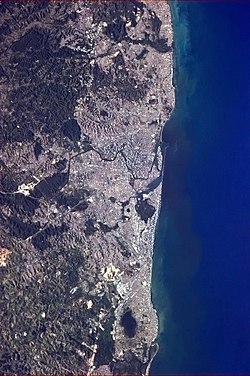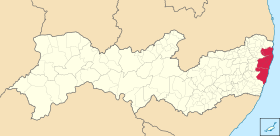Recife Metropolitan Area, officially the Metropolitan Region of Recife (Brazilian Portuguese: Região Metropolitana do Recife (RMR), or Grande Recife), is a major metropolitan area in Northeast Brazil with a population of 3,7 million as of 2022,[1][2] centered on the state capital of Recife, Pernambuco. In 2017, it was ranked as the 8th largest metropolitan region nationally.[3]
Grande Recife
Região Metropolitana do Recife (RMR) | |
|---|---|
Metro Area | |
| Metropolitan Region of Recife | |
 The RMR seen from the International Space Station | |
 The Metropolitan Region in Pernambuco (including the former member of Goiana) | |
| Country | |
| Region | Northeast |
| State | |
| Metropolitan Area established | June 8, 1973 |
| Recife as Capital | 1827 |
| Area | |
| • Metro | 2,764.26 km2 (1,067.29 sq mi) |
| Population (2022) | |
| • Metro Area | 3,726,974 |
| Time zone | UTC−3 (BRT) |
| HDI (2000) | 0,734 – high |
The Brazilian Institute of Geography and Statistics (IBGE) defines the region as a "metropolis" in its Area of Influence surveys, in terms of economic and social importance.[4] The region's area of influence covers a large part of Northeast Brazil, including the entire states of Alagoas, Paraíba, and Pernambuco, in addition to portions of Bahia, Ceará, Maranhão, Piauí, Rio Grande do Norte, and Sergipe. Within this area of influence are the smaller cities of Natal, João Pessoa, Maceió, and Aracaju.
Municipalities
editThe Metropolitan Region is defined in federal[5] and state[6] legislation as consisting of 14 municipalities. Goiana was formerly a part, but left in March 2020.[7][8] The Immediate Geographic Region (formerly termed microregion) around Recife defined by the IBGE[9] encompasses additional outlying municipalities.
| Municipality | Area (2020, km²)[10] |
Population (2010, census)[11] |
Population (2020, estimate)[2] |
GDP (2017, '000 BRL)[12] |
GDP per capita (2017, BRL)[12] |
|---|---|---|---|---|---|
| Abreu e Lima | 126,384 | 94,429 | 100,346 | 2,003,665 | 20,164.90 |
| Araçoiaba | 96,360 | 18,156 | 20,733 | 139,026 | 6,859.40 |
| Cabo de Santo Agostinho | 445,343 | 185,025 | 208,944 | 9,964,401 | 46,689.25 |
| Camaragibe | 51,321 | 144,466 | 158,899 | 1,757,192 | 11,238.05 |
| Igarassu | 306,879 | 102,021 | 118,370 | 2,479,117 | 21,483.19 |
| Ilha de Itamaracá | 66,146 | 21,884 | 26,672 | 239,399 | 9,289.99 |
| Ipojuca | 521,801 | 80,637 | 97,669 | 10,879,739 | 115,089.32 |
| Itapissuma | 73,968 | 23,769 | 26,900 | 1,398,050 | 53,081.09 |
| Jaboatão dos Guararapes | 258,724 | 644,620 | 706,867 | 13,545,569 | 19,463.25 |
| Moreno | 196,073 | 56,696 | 63,294 | 682,663 | 10,989.60 |
| Olinda | 41,300 | 377,779 | 393,115 | 5,438,691 | 13,917.85 |
| Paulista | 96,932 | 300,466 | 334,376 | 4,019,150 | 12,240.33 |
| Recife | 218,843 | 1,537,704 | 1,653,461 | 51,859,618 | 31,743.72 |
| São Lourenço da Mata | 264,190 | 102,895 | 114,079 | 1,107,308 | 9,877.95 |
| Total | 2,764.260 | 3,690,547 | 4,023,725 | 105,513,588 | — |
Transport
editAirport
editGuararapes – Gilberto Freyre International Airport serves the area, and has domestic and international flights.
Ports
editThe region is served by Suape and Recife ports.[13]
Metro
editSince 1998, an extension to the Recife Metro is being built. When ready, it will become the second largest in Brazil, after São Paulo.[15]
This system also integrates with several bus lines connected to the bus/metro[16] integration terminals, such as Barro and Joana Bezerra stations. It is possible to ride the metro and the connected bus line by purchasing one ticket only. Since March 2009, Recife Metro has finished one more phase of expansion. The system counts now has 28 stations (11 integrated with buses) and is 39.5 kilometers long. [citation needed]
Bus
editBuses transport over 3 million passengers daily[17] through 224 routes and 4,523 stops.[18]
References
edit- ^ Redator (2023-12-21). "Censo 2022: população reduz no núcleo metropolitano litorâneo e cresce nos polos de desenvolvimento da RM Recife". Observatório das Metrópoles (in Brazilian Portuguese). Retrieved 2024-07-03.
- ^ a b "Population Estimates | IBGE". www.ibge.gov.br. Brazilian Institute of Geography and Statistics. Archived from the original on 2022-08-02. Retrieved 2021-04-01.
- ^ ""Tabela 4: POPULAÇÃO DAS REGIÕES METROPOLITANAS, REGIÕES INTEGRADAS DE DESENVOLVIMENTO E AGLOMERAÇÕES URBANAS COM MAIS DE UM MILHÃO DE HABITANTES"". IBGE. Brazilian Institute of Geography and Statistics. Archived from the original on 2019-02-03. Retrieved 2021-04-01.
- ^ "Areas of Influence of Cities | IBGE". www.ibge.gov.br. Brazilian Institute of Geography and Statistics. Archived from the original on 2022-08-02. Retrieved 2021-04-01.
- ^ "Lei Complementar Federal do Brasil 14 de 1973 - Wikisource". pt.wikisource.org (in Portuguese). Archived from the original on 2021-08-01. Retrieved 2021-04-01.
- ^ "Alepe Legis - Portal da Legislação Estadual de Pernambuco". Alepe Legis - Portal da Legislação Estadual (Legislative Assembly of the State of Pernambuco) (in Brazilian Portuguese). Archived from the original on 2019-05-02. Retrieved 2021-04-01.
- ^ "Saída de Goiana da RMR é aprovada pela Alepe". www.folhape.com.br (in Brazilian Portuguese). Archived from the original on 2022-08-02. Retrieved 2021-04-01.
- ^ "IBGE reintegra município de Goiana à Zona da Mata de Pernambuco". G1 (in Brazilian Portuguese). Archived from the original on 2020-11-17. Retrieved 2021-04-01.
- ^ "Regiões Geográficas". www.ibge.gov.br. Brazilian Institute of Geography and Statistics. Geographic Regions in the State of Pernambuco. Archived from the original on 2021-06-08. Retrieved 2021-04-01.
- ^ "Territorial Areas | IBGE". www.ibge.gov.br. Brazilian Institute of Geography and Statistics. Archived from the original on 2022-08-02. Retrieved 2021-04-01.
- ^ "Population Census | IBGE". www.ibge.gov.br. Brazilian Institute of Geography and Statistics. Table 3.1. Archived from the original on 2021-04-24. Retrieved 2021-04-01.
- ^ a b "Gross Domestic Product of Municipalities | IBGE". www.ibge.gov.br. Brazilian Institute of Geography and Statistics. 2010-2018 base. Archived from the original on 2022-08-02. Retrieved 2021-04-01.
- ^ Rafael. "O que fazer em Recife? Dicas Para Você Aproveitar Recife" (in European Portuguese). Archived from the original on 2022-08-02. Retrieved 2021-04-05.
- ^ "Qual é o maior metrô do Brasil?". Super (in Brazilian Portuguese). Archived from the original on 2021-05-07. Retrieved 2022-08-02.
- ^ Recife Metro (in Portuguese). Recife, Brazil: Diário de Pernambuco. 2006. ISBN 85-240-3919-1. Archived from the original (PDF) on 2008-02-02. Retrieved 2007-07-18.
- ^ Recife Metro (in Portuguese). Recife, Brazil: CBTU. 2006. ISBN 85-240-3919-1. Archived from the original (PDF) on 2008-02-02. Retrieved 2007-07-18.
- ^ "Reajuste é considerado alto pelos usuários de ônibus do Grande Recife". www.uol.com.br. Retrieved 2022-08-02.
- ^ "Grande Recife, Recife e Região – ônibus Horários, Rotas e Atualizações". moovitapp.com (in Brazilian Portuguese). Retrieved 2022-08-02.